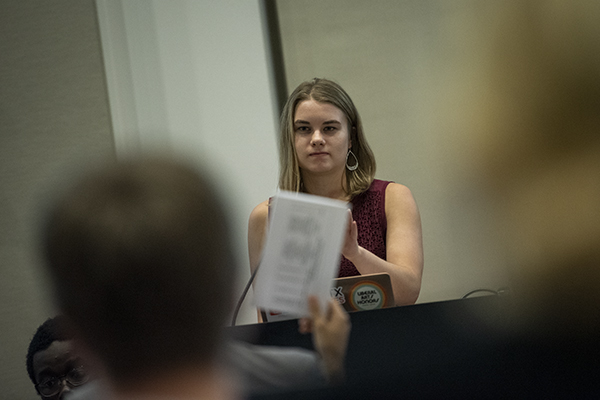Social work junior Sara Jane Ross said she opened a Title IX case believing a no-contact directive would stop her assailant from joining her classes. Approximately a week later, she said she learned it would not.
“No one told me at the beginning that no-contact directives didn’t cover classes,” said Ross, the SG interpersonal violence prevention director. “If I had known, I probably wouldn’t have opened a Title IX case. That would've saved me a year of heartache.”
The Title IX can enforce a noncontact directive, which prevents contact between two or more people to protect student safety. Ross said she collaborated with Elena Ivanova, Senate of College Councils president, to write a specific definition of what it covers.
Ross also authored a resolution supporting its addition to the Title IX website, the Office of the Dean of Students website and the general information catalogue. Ivanova, a public health, government and Plan II senior, authored and introduced the resolution at the Senate meeting Thursday.
“It is just ensuring that if students have to go through something as awful as having to report something, they should at least know what resources are available,” Ivanova said. “There should be information available about the Title IX process that isn’t in some confusing document.”
The proposed definition includes a paragraph about the directive, stating it “does not prevent individuals from being in the same place, class, discussion section, lab or seeing one another on or off campus,” according to the resolution.
“It’s important they are given more information rather than less,” Ivanova said. “It can help them form decisions about proceeding or not proceeding.”
Ivanova said Title IX defines terms like “complainant,” “respondent” and “Title IX” but does not define the directive. She wants to work with the Title IX office and UT’s legal team to ensure the definition is as accurate as possible before it is published online.
“If this could be looked at legally before we vote, just because people want to see the final look and be a part of the final conversation, it would be useful,” said Praveena Javvadi, a government and Plan II junior and vice president of the Liberal Arts Council.
Further defining the directive is a part of the Senate’s agenda, according to the Senate’s legislative agenda for 2019-20.
“We started with this idea to allow for increased applicability of the (directive),” Ivanova said. “But because there are some cases that require one thing and other cases that are different, it’s difficult to create a universal policy. So, instead we want to inform students on what’s already existing.”
Ivanova said she still hopes the resolution allows for further changes to the policy.
“This is a baseline step because getting information out there is good and critical, but after this, we need to think about what happens next,” Ivanova said. “Is this policy really beneficial? Potentially, students who are informed can think of other solutions.”
Ross said her next step would expand the directive’s capabilities but that it will be hard.
“I’m definitely going to try and push and get more information, but this is what we can do at the moment,” Ross said. “This isn’t everything we wanted, but it’s a great start.”





















